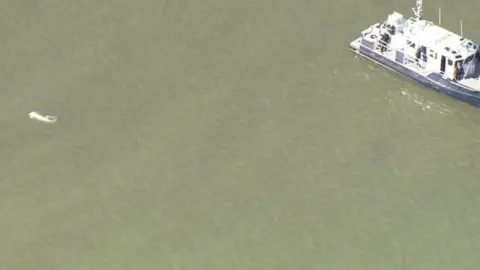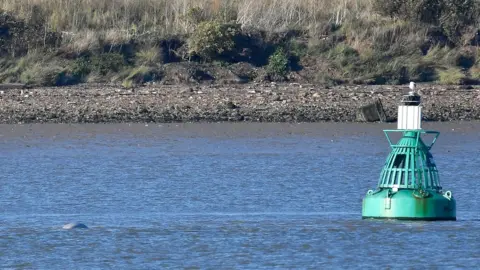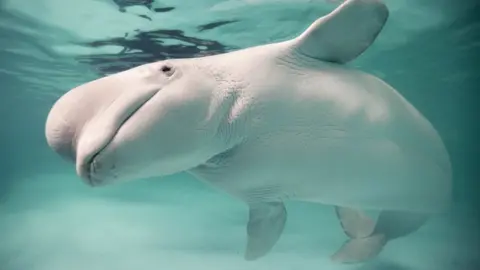Beluga whale spotted in the Thames off Gravesend
A beluga whale has been seen swimming in the River Thames.
It was first spotted by ecologist and ornithologist Dave Andrews, who said it had been feeding around barges near Gravesend in Kent.
The Whale and Dolphin Conservation said it was "obviously very lost and quite possibly in trouble".
Vessels are being kept clear, with the British Divers Marine Life Rescue urging the public not to get too close and "to watch it from the shore".

 Reuters
ReutersTanya Ferry, environment manager at the Port of London Authority which is monitoring the whale, said it was unclear what the whale could eat.
"We do have quite a lot of plastic bags, which could be quite an issue," she said.
"We're hoping if we give it enough space and keep an eye on it, it will find its own way out of the Thames to an environment that's more appropriate for it.
"We certainly don't want people trying to rescue it."
 Reuters
ReutersConservationists hope the outgoing tide will take it to safer waters.
Beluga whales were last spotted in the UK three years ago off the coast of Northumberland and Northern Ireland, but sightings were "extremely rare", British Divers Marine Life Rescue spokeswoman Julia Cable said.
She added the animal was "swimming strongly" and it would hopefully swim back out to sea.

Whale and Dolphin Conservation Society spokesman Danny Groves said as the whales were high Arctic species, "this one is thousands of miles from where it should be".
"We would urge that the whale is given space and disturbance is kept to a minimum," he said.
In 2006 an 18ft (5m) northern bottle-nosed whale died after becoming stranded in the Thames.

You may also like:

The RSPCA said it was aware of reports of a whale in the Thames.
"We are working with other agencies to monitor the situation and ready to provide appropriate assistance if requested," it said.
Allow X content?
Richard Sabin, principal curator of mammals at the Natural History Museum, said photos and videos he had seen appeared to show a beluga whale.
"The white body colour, absence of a prominent dorsal fin, bulbous forehead and general swimming motion all suggest this very strongly," he said.
"The beluga is an Arctic/sub-Arctic species, so is a long way outside its usual range of distribution."

What is a beluga whale?
 RIA NOVOSTI/SCIENCE PHOTO LIBRARY
RIA NOVOSTI/SCIENCE PHOTO LIBRARYBelugas, also known as white whales, are "one of the most familiar and easily distinguishable" of all whales, according to National Geographic.
They range from 13ft (3.9m) to 20ft (6.1m) in length and have distinctive rounded foreheads.
Belugas are commonly found in coastal waters of the Arctic Ocean, but are also at home in large rivers. They can move between salt and fresh water.
They are common to Alaska, Russia, Canada, and Greenland.
The whales were nicknamed "canaries of the sea" by early whalers due to their squeaks and squawks.
Beluga calls variously resemble a cork being prized from a bottle or a creaking door, along with sounds described as clicks, squeaks, chirps, bleats, moans, groans, and whistles.
